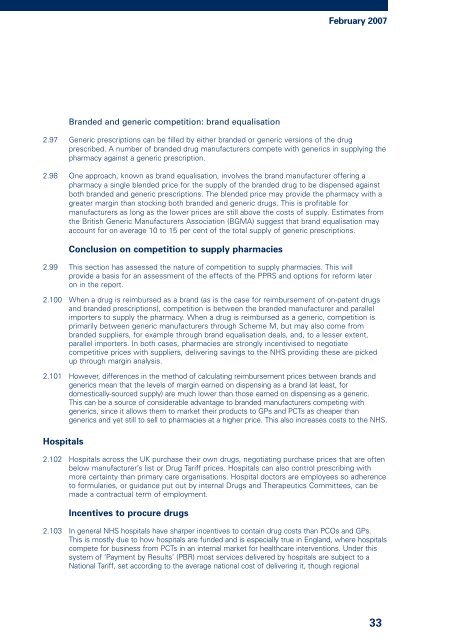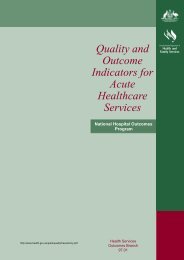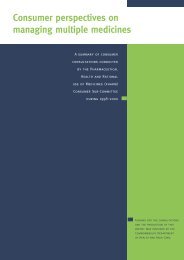The Pharmaceutical Price Regulation Scheme - Office of Fair Trading
The Pharmaceutical Price Regulation Scheme - Office of Fair Trading
The Pharmaceutical Price Regulation Scheme - Office of Fair Trading
Create successful ePaper yourself
Turn your PDF publications into a flip-book with our unique Google optimized e-Paper software.
February 2007<br />
Branded and generic competition: brand equalisation<br />
2.97 Generic prescriptions can be filled by either branded or generic versions <strong>of</strong> the drug<br />
prescribed. A number <strong>of</strong> branded drug manufacturers compete with generics in supplying the<br />
pharmacy against a generic prescription.<br />
2.98 One approach, known as brand equalisation, involves the brand manufacturer <strong>of</strong>fering a<br />
pharmacy a single blended price for the supply <strong>of</strong> the branded drug to be dispensed against<br />
both branded and generic prescriptions. <strong>The</strong> blended price may provide the pharmacy with a<br />
greater margin than stocking both branded and generic drugs. This is pr<strong>of</strong>itable for<br />
manufacturers as long as the lower prices are still above the costs <strong>of</strong> supply. Estimates from<br />
the British Generic Manufacturers Association (BGMA) suggest that brand equalisation may<br />
account for on average 10 to 15 per cent <strong>of</strong> the total supply <strong>of</strong> generic prescriptions.<br />
Conclusion on competition to supply pharmacies<br />
2.99 This section has assessed the nature <strong>of</strong> competition to supply pharmacies. This will<br />
provide a basis for an assessment <strong>of</strong> the effects <strong>of</strong> the PPRS and options for reform later<br />
on in the report.<br />
2.100 When a drug is reimbursed as a brand (as is the case for reimbursement <strong>of</strong> on-patent drugs<br />
and branded prescriptions), competition is between the branded manufacturer and parallel<br />
importers to supply the pharmacy. When a drug is reimbursed as a generic, competition is<br />
primarily between generic manufacturers through <strong>Scheme</strong> M, but may also come from<br />
branded suppliers, for example through brand equalisation deals, and, to a lesser extent,<br />
parallel importers. In both cases, pharmacies are strongly incentivised to negotiate<br />
competitive prices with suppliers, delivering savings to the NHS providing these are picked<br />
up through margin analysis.<br />
2.101 However, differences in the method <strong>of</strong> calculating reimbursement prices between brands and<br />
generics mean that the levels <strong>of</strong> margin earned on dispensing as a brand (at least, for<br />
domestically-sourced supply) are much lower than those earned on dispensing as a generic.<br />
This can be a source <strong>of</strong> considerable advantage to branded manufacturers competing with<br />
generics, since it allows them to market their products to GPs and PCTs as cheaper than<br />
generics and yet still to sell to pharmacies at a higher price. This also increases costs to the NHS.<br />
Hospitals<br />
2.102 Hospitals across the UK purchase their own drugs, negotiating purchase prices that are <strong>of</strong>ten<br />
below manufacturer’s list or Drug Tariff prices. Hospitals can also control prescribing with<br />
more certainty than primary care organisations. Hospital doctors are employees so adherence<br />
to formularies, or guidance put out by internal Drugs and <strong>The</strong>rapeutics Committees, can be<br />
made a contractual term <strong>of</strong> employment.<br />
Incentives to procure drugs<br />
2.103 In general NHS hospitals have sharper incentives to contain drug costs than PCOs and GPs.<br />
This is mostly due to how hospitals are funded and is especially true in England, where hospitals<br />
compete for business from PCTs in an internal market for healthcare interventions. Under this<br />
system <strong>of</strong> ‘Payment by Results’ (PBR) most services delivered by hospitals are subject to a<br />
National Tariff, set according to the average national cost <strong>of</strong> delivering it, though regional<br />
33




